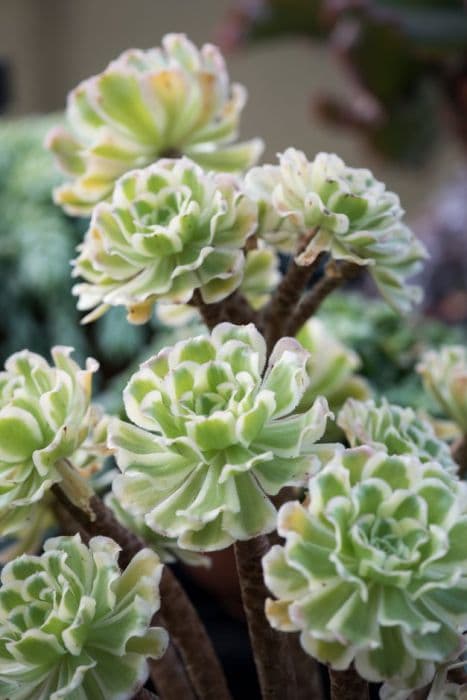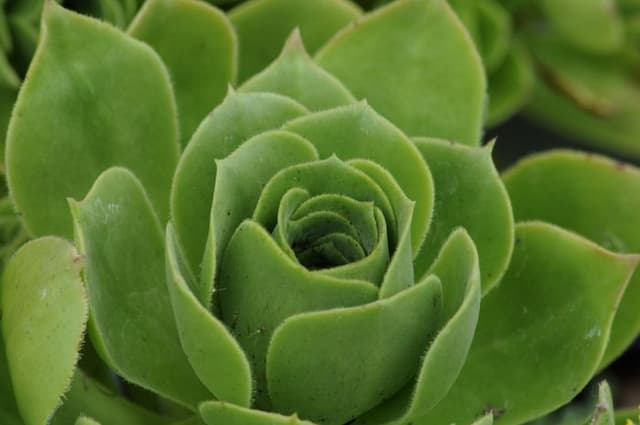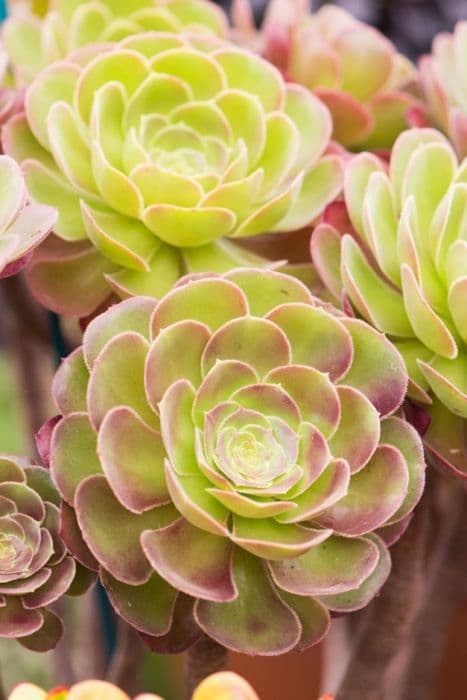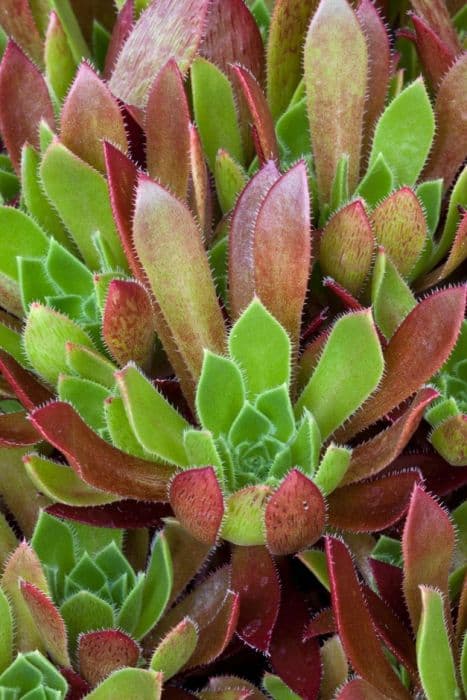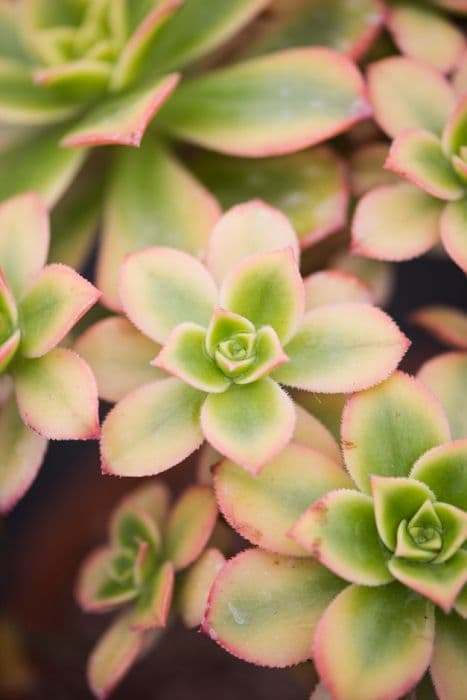Stonecrop Hylotelephium telephium 'Jennifer'

ABOUT
The plant known commonly as 'Jennifer' Sedum is characterized by its distinctly attractive foliage and flowers. The leaves of this cultivar usually possess a fleshy texture, which is a characteristic of many stonecrops, and they exhibit a rich, deep green color with undertones that can range from purple to bronze, especially as the cooler weather sets in. Throughout the growing season, the foliage maintains its lush appearance, creating a dense mat that can be quite appealing in a garden setting. As the seasons progress, 'Jennifer' Sedum blooms with clusters of star-shaped flowers. These blossoms tend to be a vibrant pink color, which contrasts beautifully against the darker foliage. The flowers are typically small individually, but they are numerous and form prominent clusters that make a striking visual impact. It's common for these flowers to attract a variety of pollinators, including bees and butterflies, adding a dynamic element to the garden as these creatures visit the plant. Sedums like 'Jennifer' are known for their hardiness and can thrive under a variety of conditions, often requiring minimal care once established. This makes them a popular choice for gardeners looking for reliable and visually appealing plants. The succulent-like leaves and the clusters of pink flowers combine to give 'Jennifer' Sedum a robust and colorful presence in the landscape, even though the plant's specific dimensions are not being discussed here.
About this plant
 Names
NamesFamily
Crassulaceae
Synonyms
Orpine, Stonecrop, Live Forever, Livelong, Frog's-stomach, Harping Johnny, Life-everlasting, Witch's Moneybags, Midsummer-men, Orphan John, Aaron's Rod
Common names
Hylotelephium spectabile 'Jennifer', Sedum spectabile 'Jennifer', Sedum telephium 'Jennifer'.
 Toxicity
ToxicityTo humans
The common name for Hylotelephium telephium 'Jennifer' is Stonecrop. Stonecrop is generally not considered toxic to humans; however, as with many plants, it may cause mild irritation or an allergic reaction if ingested in large quantities or if there is skin contact in sensitive individuals. If significant ingestion occurs, symptoms might include gastrointestinal discomfort, such as nausea, vomiting, or diarrhea. It is advisable to keep plants out of reach of small children who might accidentally ingest them.
To pets
Stonecrop is known to have a similar level of toxicity to pets as to humans, meaning it is not considered highly toxic. However, the ingestion of Stonecrop can occasionally lead to gastrointestinal upset in pets as well, including symptoms like vomiting or diarrhea. As such, it's best to prevent pets from ingesting large amounts of the plant to avoid these potential mild adverse effects. If a pet does consume a significant amount of Stonecrop and displays symptoms, consulting with a veterinarian is advised.
 Characteristics
CharacteristicsLife cycle
Perennials
Foliage type
Deciduous
Color of leaves
Green
Flower color
Pink
Height
1-2 feet (30-60 cm)
Spread
1-2 feet (30-60 cm)
Plant type
Succulent
Hardiness zones
3-9
Native area
Europe
Benefits
 General Benefits
General Benefits- Attracts Pollinators: Hylotelephium telephium 'Jennifer' attracts bees and butterflies, which are vital for pollination of many plants and crops.
- Drought Tolerance: The plant is known for its ability to withstand periods of drought, making it a low-maintenance option for gardeners in dry climates.
- Easy to Propagate: It can be easily propagated from cuttings or leaves, allowing gardeners to create more plants for their gardens or to share with others.
- Seasonal Interest: With its colorful foliage and flowers, it provides visual interest in the garden throughout its growing season, especially in late summer and early fall.
- Suitable for Xeriscaping: Its low water requirements make it well-suited to xeriscaping, a landscaping method that reduces or eliminates the need for supplemental water from irrigation.
- Provides Structure: Its sturdy and upright growth habit can add structure and form to garden designs.
- Winter Hardiness: This plant is cold-hardy, able to survive and thrive in cooler temperatures, which makes it a good choice for temperate regions.
- Low Maintenance: 'Jennifer' does not require frequent fertilization or pruning, making it an ideal plant for those seeking a low-maintenance garden.
- Soil Adaptability: It can adapt to a wide range of soil conditions, as long as the soil is well-drained.
 Medical Properties
Medical PropertiesThis plant is not used for medical purposes.
 Air-purifying Qualities
Air-purifying QualitiesThis plant is not specifically known for air purifying qualities.
 Other Uses
Other Uses- Botanical Illustration Subject: Hylotelephium telephium, commonly known as stonecrop, can be used as a beautiful and intricate subject for botanical illustration due to its detailed leaves and striking flower clusters.
- Photography Projects: Stonecrop's robust form and color contrast well against natural landscapes, making it an excellent candidate for garden photographers or those practicing macro photography.
- Educational Tool: Stonecrop can be used in educational settings to teach about drought-tolerant gardening and the importance of succulents in ecosystem conservation.
- Natural Crafting Material: The dried flower heads can be used in floral displays or natural craft projects to add an element of rustic charm.
- Garden Design: With its attractive foliage, stonecrop can be used in garden design to create texture and year-round interest in rock gardens, borders, and ground covers.
- Erosion Control: Because of its robust root system, stonecrop can help stabilize soil and control erosion on slopes or in areas prone to runoff.
- Xeriscaping: Stonecrop is an ideal component in xeriscaped gardens that require minimal irrigation, helping to conserve water.
- Insect Habitat: The dense foliage and flowers provide shelter and food for beneficial insects, making stonecrop a practical addition to a bug-friendly garden.
- Artistic Inspiration: Stonecrop's unique form and seasonal changes can serve as inspiration for artists and sculptors, particularly those interested in natural forms and structures.
- Green Roofing: Due to its low maintenance and drought resistance, stonecrop can be used in green roofing projects, adding insulation and reducing heat island effect in urban areas.
Interesting Facts
 Feng Shui
Feng ShuiThe Stonecrop is not used in Feng Shui practice.
 Zodiac Sign Compitability
Zodiac Sign CompitabilityThe Stonecrop is not used in astrology practice.
 Plant Symbolism
Plant Symbolism- Resilience: Also known as Stonecrop, Hylotelephium telephium 'Jennifer' is representative of the ability to thrive in harsh conditions due to its succulent nature, indicating strength and endurance.
- Adaptability: As a plant that can adapt to different soil types and weather conditions, Stonecrop symbolizes flexibility and the capacity for change.
- Resourcefulness: With its efficient use of water and nutrients, Stonecrop symbolizes making the most out of available resources and opportunities.
- Perseverance: This plant's tenacious habit of growth, even when neglected, signifies perseverance and a never-give-up attitude.
- Longevity: Stonecrop is known for its longevity and can live for many years, symbolizing a long life and eternal devotion in relationships.
- Peace: The green foliage and subtle hues of the flowers can bring a sense of calm and tranquility, marking it as a representation of peace and serenity.
 Water
WaterFor Stonecrop 'Jennifer,' water should be provided deeply but infrequently, aiming to soak the root zone. During the active growing season in spring and summer, watering once every two weeks with approximately 0.5 gallons per square foot should suffice, adjusting for rainfall. During dormant periods in late fall and winter, reduce watering to once a month or less. Always allow the soil to dry out between waterings to prevent root rot, which this plant is prone to if overwatered.
 Light
LightStonecrop 'Jennifer' thrives best in full sun to partial shade. It should be placed in a spot where it can receive at least 6 hours of sunlight each day. Dappled sunlight is acceptable during the hottest part of the day to prevent scorching.
 Temperature
TemperatureFor Stonecrop 'Jennifer,' the ideal temperature range is between 65°F and 75°F during the growing season. It is a hardy plant that can tolerate temperatures as low as 30°F, making it suitable for cooler climates. However, it should be protected from extreme cold, as temperatures below freezing can be detrimental to the plant's health.
 Pruning
PruningFor Stonecrop 'Jennifer,' pruning is beneficial to maintain its shape and promote denser growth. Trimming should be done in the early spring, removing dead or damaged stems and spent flowers from the previous season. Prune cautiously, as excessive cutting can harm the plant.
 Cleaning
CleaningAs needed
 Soil
SoilAutumn Joy Sedum, commonly known as Hylotelephium telephium 'Jennifer', thrives best in a well-draining soil mix comprising one part potting soil, one part perlite or coarse sand, and one part compost or peat moss. Optimal soil pH for Autumn Joy Sedum should be slightly acidic to neutral, in the range of 6.0 to 7.0.
 Repotting
RepottingAutumn Joy Sedum does not require frequent repotting and can often be left undisturbed for several years. Generally, repotting every 3-4 years, or when the plant outgrows its current container, is sufficient to maintain its health and vigor.
 Humidity & Misting
Humidity & MistingAutumn Joy Sedum prefers low to average humidity levels and is quite tolerant of dry air, making it suitable for typical indoor environments. It does not require any special humidity considerations.
 Suitable locations
Suitable locationsIndoor
Place in bright light, minimal water.
Outdoor
Full sun to partial shade, well-drained soil.
Hardiness zone
3-9 USDA
 Life cycle
Life cycleHylotelephium telephium 'Jennifer', commonly known as Stonecrop 'Jennifer', starts its life cycle as a seed, which, when planted in well-draining soil and with proper light, will germinate to produce a small seedling. The seedling grows into a rosette of thick, succulent leaves, which then develops robust, fleshy stems. During the growing season, it undergoes vegetative growth, accumulating resources in its leaves and stems. The stonecrop reaches maturity and produces clusters of star-shaped, often pink or red flowers in late summer to early autumn, attracting pollinators such as bees and butterflies. After flowering, the plant produces seeds which can be dispersed by wind or wildlife, thus completing the cycle. During winter, the plant may die back to the ground, with the root system remaining dormant until the return of favorable conditions in spring.
 Propogation
PropogationPropogation time
Late summer
Propogation: Hylotelephium telephium 'Jennifer', commonly known as Stonecrop 'Jennifer', is best propagated by stem or leaf cuttings during its active growth period, which is typically in spring or early summer. To propagate Stonecrop 'Jennifer', one would typically select a healthy piece of stem around 2 to 4 inches (5 to 10 centimeters) in length. Remove the lower leaves and allow the cut end of the stem to callous over for a few days to reduce the risk of rot. After the cutting has formed a callous, it can be planted in well-draining soil. Water it sparingly until roots develop, usually within a few weeks, at which point you can begin to water it more regularly as you would a mature plant. This method is popular due to its simplicity and high success rate.
